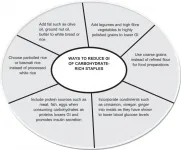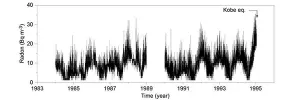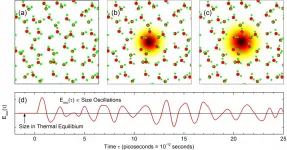Determination of glycine transporter opens new avenues in development of psychiatric drugs
2021-03-04
(Press-News.org) Glycine can stimulate or inhibit neurons in the brain, thereby controlling complex functions. Unraveling the three-dimensional structure of the glycine transporter, researchers have now come a big step closer to understanding the regulation of glycine in the brain. These results, which have been published in Nature, open up opportunities to find effective drugs that inhibit GlyT1 function, with major implications for the treatment of schizophrenia and other mental disorders.
Glycine is the smallest amino acid and a building block of proteins, and also a critical neurotransmitter that can both stimulate or inhibit neurons in the brain and thereby control complex brain functions. Termination of a glycine signal is mediated by glycine transporters that reuptake and clear glycine from the synapses between neurons. Glycine transporter GlyT1 is the main regulator of neurotransmitter glycine levels in the brain, and also important for e.g. blood cells, where glycine is required for the synthesis of heme.
The N-methyl-D-aspartate (NMDA) receptor is activated by glycine, and its poor performance is implicated in schizophrenia. Over the past twenty years, many pharmaceutical companies and academic research laboratories therefore have focused on influencing glycinergic signaling and glycine reuptake delay as a way of activating the NMDA receptor in search of a cure for schizophrenia and other psychiatric disorders. Indeed, several potent and selective GlyT1 inhibitors achieve antipsychotic and pro-cognitive effects alleviating many symptoms of schizophrenia, and have advanced into clinical trials. However, a successful drug candidate has yet to emerge, and GlyT1 inhibition in blood cells is a concern for side effects. Structural insight into the binding of inhibitors to GlyT1 would provide insight in finding new strategies in drug design.
To gain better knowledge about the three-dimensional structure and inhibition mechanisms of the GlyT1 transporter, researchers from the companies Roche and Linkster, and from the European Molecular Biology Laboratory (EMBL) Hamburg, University of Zurich and Aarhus University, have therefore collaborated on investigating one of the most advanced GlyT1 inhibitors. Using a synthetic single-domain antibody (Linkster therapeutics'sybody®) for GlyT1, the research team managed to grow microcrystals of the inhibited GlyT1 complex. By employing a Serial Synchrotron Crystallography (SSX) approach, the team lead by Assistant Professor Azadeh Shahsavar and Professor Poul Nissen from the Department of Molecular Biology and Genetics/DANDRITE, Aarhus University, determined the structure of human GlyT1 using X-ray diffraction data from hundreds of microcrystals. The SSX method is particularly suitable as a method fornew, powerful X-ray sources and opens up for new approaches to, among other things, the development of drugs for various purposes.
The structure is reported in the leading scientific journal Nature and also unveils a new mechanism of inhibition in neurotransmitter transporters in general. Mechanisms have previously been uncovered for, for example, inhibition of the serotonin transporter (which has many similarities to GlyT1) with antidepressant drugs, but it is a quite different inhibition mechanism now found for GlyT1. It provides background knowledge for the further development of small molecules and antibodies as selective inhibitors targeted at GlyT1 and possibly also for new ideas for the development of inhibitors of other neurotrandmitter carriers that can be used to treat other mental disorders. Azadeh Shahsavar's team continues the studies of GlyT1 and will be investigating further aspects of its function and inhibition and the effect of GlyT1 inhibitors in the body.
INFORMATION:
The studies have received financial support from the Novo Nordisk Foundation, the Lundbeck Foundation, the EU-Marie Sklodowska Curie Cofund (EMBL EIPOD postdoc fellowship) and Roche.
The results have been published in the international journal Nature:
Structural insights into the inhibition of glycine reuptake
Azadeh Shahsavar, Peter Stohler, Gleb Bourenkov, Iwan Zimmermann, Martin Siegrist, Wolfgang Guba, Emmanuel Pinard, Steffen Sinning, Markus A. Seeger, Thomas R. Schneider, Roger J. P. Dawson & Poul Nissen
https://doi.org/10.1038/s41586-021-03274-z
For further information, please contact
Assistant Professor Azadeh Shahsavar - ash@mbg.au.dk
Professor Poul Nissen - pn@mbg.au.dk - +45 28992295
Danish Research Institute of Translational Neuroscience--DANDRITE
Nordic EMBL Partnership for Molecular Medicine
Department of Molecular Biology and Genetics
Aarhus University, Denmark
[Attachments] See images for this press release:

ELSE PRESS RELEASES FROM THIS DATE:
2021-03-04
The oceans are becoming more acidic because of the rapid release of carbon dioxide (CO2) caused by anthropogenic (human) activities, such as burning of fossil fuels. So far, the oceans have taken up around 30% of all anthropogenic CO2 released to the atmosphere. The continuous increase of CO2 has a substantial effect on ocean chemistry because CO2 reacts with water and carbonate molecules. This process, called 'ocean acidification', lowers pH, and calcium carbonate becomes less available. This is a problem for calcifying organisms, such as corals and molluscs, that use calcium carbonate as the main building blocks of their exoskeleton.
In particular, organisms that build their shells from a type of calcium carbonate known as 'aragonite' are in trouble because aragonite is ...
2021-03-04
?Micro-Doppler radars could soon be used in clinical settings to predict injury risk and track recovery progress, according to Penn State researchers.?
Being able to view subtle differences in human movement?would allow health care workers to more accurately identify individuals who may be at risk for injury and to track progress precisely while individuals are recovering from an injury. In an effort to find an accurate, reliable and cost-effective way to measure these subtleties ?in human movement, College of Engineering and College of Medicine researchers teamed up to develop a radar in front ...
2021-03-04
Professor Christiani Jeyakumar Henry, Senior Advisor of Singapore Institute of Food and Biotechnology Innovation (SIFBI), Agency for Science, Technology and Research (A*STAR) and his team have developed a Glycaemic Index (GI) glossary of non-Western foods. The research paper was published in Nutrition & Diabetes on 6 Jan 2021: https://doi.org/10.1038/s41387-020-00145-w.
Observational studies have shown that the consumption of low glycaemic index (GI) foods is associated with a lower risk of type 2 diabetes mellitus (T2DM), significantly less insulin resistance and a lower prevalence of the metabolic syndrome. However, most published GI values focus on Western foods with minimal inclusion of other foods from non-Western countries, hence their application ...
2021-03-04
Tohoku University researchers have unearthed further details about radon concentration in the atmosphere before and after earthquakes, moving us closer to being able to anticipate when large earthquakes may hit.
The results of their research were published in the journal Science Reports on February 18, 2021.
Radon is a radioactive noble gas derived from radioactive decays of radium-226 in the ground. Radon bubbles up to the surface and is expelled into the atmosphere.
It has long been known that elevated levels of radon underneath the ground can be detected before and after earthquakes. But the relationship between the mechanisms that cause abnormal changes in radon concentration and the occurrence of earthquakes requires greater ...
2021-03-04
Interspecies interactions are the foundation of ecosystems, from soil to ocean to human gut. Among the many different types of interactions, syntrophy is a particularly important and mutually beneficial interspecies interaction where one partner provides a chemical or nutrient that is consumed by the other in exchange for a reward.
Syntrophy plays an essential role in global carbon cycles by mediating the conversion of organic matter to methane, which is about 30 times more potent than carbon dioxide as a greenhouse gas and is a source of sustainable energy. And in the human gut, trillions of microbial cells also interact ...
2021-03-04
Intelligent holographic nanostructures on CMOS sensors for energy-efficient AI security schemes
Today, machine learning permeates our everyday life, with millions of users every day unlocking their phones through facial recognition or passing through AI-enabled automated security checks at airports and train stations. These tasks are possible thanks to sensors that collect optical information to feed it to a neural network in a computer. Imagine to empower the sensors in the devices you use every day to perform artificial intelligence functions without a computer - as simply as putting glasses on them.
The integrated holographic perceptrons developed by a research team at University of Shanghai for Science and Technology led ...
2021-03-04
Nairobi/Paris, 4 March 2021 - An estimated 931 million tonnes of food, or 17% of total food available to consumers in 2019, went into the waste bins of households, retailers, restaurants and other food services, according to new UN research conducted to support global efforts to halve food waste by 2030.
The weight roughly equals that of 23 million fully-loaded 40-tonne trucks -- enough bumper-to-bumper to circle the Earth 7 times.
The Food Waste Index Report 2021, from the United Nations Environment Programme (UNEP) and partner organization WRAP, looks at food waste that occurs in retail outlets, restaurants and homes - ...
2021-03-04
People with higher incomes tend to feel prouder, more confident and less afraid than people with lower incomes, but not necessarily more compassionate or loving, according to research published by the American Psychological Association.
In a study of data from 162 countries, researchers found consistent evidence that higher income predicts whether people feel more positive "self-regard emotions," including confidence, pride and determination. Lower income had the opposite effect, and predicted negative self-regard emotions, such as sadness, fear and shame. The research was published online in the journal Emotion. ...
2021-03-04
A group of researchers, spanning six universities and three continents, are sounding the alarm on a topic not often discussed in the context of conservation--misinformation.
In a recent study published in FACETS, the team, including Dr. Adam Ford, Canada Research Chair in Wildlife Restoration Ecology, and Dr. Clayton Lamb, Liber Ero Fellow, both based in the Irving K. Barber Faculty of Science, explain how the actions of some scientists, advocacy groups and the public are eroding efforts to conserve biodiversity.
"Outcomes, not intentions, should be the basis for how we view success in conservation," says Dr. Ford.
"Misinformation related to vaccines, climate change, and links between smoking ...
2021-03-04
Ionization of water molecules by light generates free electrons in liquid water. After generation, the so-called solvated electron is formed, a localized electron surrounded by a shell of water molecules. In the ultrafast localization process, the electron and its water shell display strong oscillations, giving rise to terahertz emission for tens of picoseconds.
Ionization of atoms and molecules by light is a basic physical process generating a negatively charged free electron and a positively charged parent ion. If one ionizes liquid water, the free electron undergoes a sequence of ultrafast processes by which it loses energy and eventually localizes at a new site in ...
LAST 30 PRESS RELEASES:
[Press-News.org] Determination of glycine transporter opens new avenues in development of psychiatric drugs





